Liqueurs: A Complete Guide

In this article, Eddie Baitz provides insights into the complexities of the art of the Master Liqueurist. The contents have evolved from lectures which he prepared for both the trade and consumers, covering the origins, production methods, varieties and appreciation of liqueurs.
Apart from the wonderful experience of drinking liqueurs straight or on the rocks, there is a chapter on cocktails and recipes for mixing drinks. Liqueurs today are used increasingly in cooking and so we conclude with some recipes. Mr.Baitz also outlines the point system as used by all the leading liqueur Judges at the various shows throughout Australia. We hope that after reading these pages, your experiences with liqueurs will become ever more enjoyable.
A History of Liqueurs
It is not easy to put a precise date or time on the beginnings of Liqueurs but we can trace how they commenced to emerge in rudimentary fashion and to develop into those we know today. Wine is one of the oldest alcoholic beverages known to man and it has been made by the fermentation of grape juice since the beginning of recorded history and well before Biblical times. Fermentation is merely the natural process by which yeast, or Saccharomyces, which occurs spontaneously on the skin of fresh grapes acts on the grape sugar producing alcohol and carbon dioxide gas. This is stating the case very simply of course.
The process of distillation became known nearly four hundred years before Christ was born. Aristotle distilled pure water from sea water about 350 BC by a heat evaporative process and later, Pliny the Elder, about 50 AD, describes the distillation of wood oils in a similar procedure. It was therefore an easy step to apply 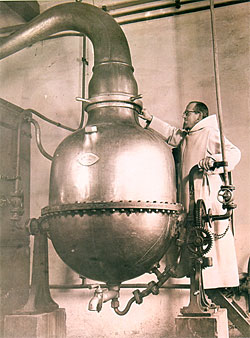 distillation to wine. Those who first did so may have been attempting to concentrate the wine by removing the water content and found that what they had removed, that is the Spirit, was far more rewarding than that which remained. A Wine Merchant of La Rochelle in the Charente region of France where the English vessels used to call for salt and whose name was M. Croix-Maron was much involved with reducing the bulk of his wines to save space in the English ships, and having boiled his wine, he is said to have remarked, "In cooking my wines, I have discovered their souls". In any case "Eau de Vie", Water of Life, had been discovered and would never be allowed to be lost to mankind again. But it was the Alchemists who first used this Spirit or alcohol in what came to be the forerunners of today's Liqueurs.
distillation to wine. Those who first did so may have been attempting to concentrate the wine by removing the water content and found that what they had removed, that is the Spirit, was far more rewarding than that which remained. A Wine Merchant of La Rochelle in the Charente region of France where the English vessels used to call for salt and whose name was M. Croix-Maron was much involved with reducing the bulk of his wines to save space in the English ships, and having boiled his wine, he is said to have remarked, "In cooking my wines, I have discovered their souls". In any case "Eau de Vie", Water of Life, had been discovered and would never be allowed to be lost to mankind again. But it was the Alchemists who first used this Spirit or alcohol in what came to be the forerunners of today's Liqueurs. 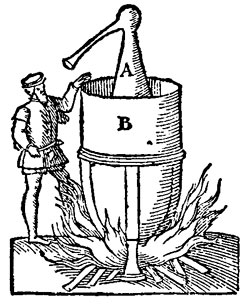 "Science" has emerged over the past thousand years as the organised and tested logic and knowledge of the laws which govern natural and physical phenomena. Processes, actions and reactions are tested, checked and recorded to provide scientific fact and knowledge. Alchemists were not scientists in the now accepted meaning of the term, since their chemistry was almost wholly limited to the pursuit of the transmutation of baser metals into gold and the search for the elixir of life. Nowadays of course our Scientists are more modest in their aspirations. And they constantly seek drugs and medical procedures which will extend life expectancy.
"Science" has emerged over the past thousand years as the organised and tested logic and knowledge of the laws which govern natural and physical phenomena. Processes, actions and reactions are tested, checked and recorded to provide scientific fact and knowledge. Alchemists were not scientists in the now accepted meaning of the term, since their chemistry was almost wholly limited to the pursuit of the transmutation of baser metals into gold and the search for the elixir of life. Nowadays of course our Scientists are more modest in their aspirations. And they constantly seek drugs and medical procedures which will extend life expectancy.
The Alchemists however in their searches were responsible for the prototypes of what we know today as Liqueurs. Today's Liqueur Kitchen is a far cry from the Alchemist's den of the middle ages but there are remarkable similarities nevertheless. There is a Laboratory still, used for making Spirit and essential oils. In those days it was called an Alembic from two Arabic words meaning "the still". It was traditionally pear shaped and the most recently built Pot-Stills of Scotland and Cognac follow this basic shape. (A very primitive still is illustrated above).
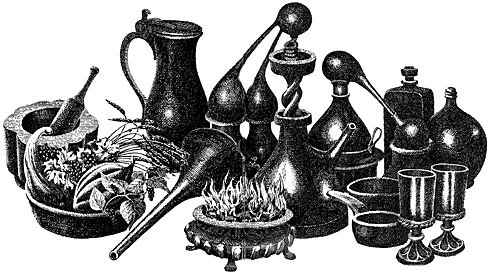
If we try to visualise the alchemist's laboratory, we can imagine there being a pestle and mortar for grinding to fine powder, the various beans, nuts and spices. There are the beans and spices themselves. And there are the flowers, herbs, fruits and other ingredients which lend life, colour, aroma and flavour to our liqueurs. Also, too, there are the casks for storage of Liqueurs for their maturation process because liqueurs, like good wine, all need a period of time to rest and settle and mature before they are bottled. There are books everywhere because the alchemists realised what we accept today, that processes must be recorded so that they can be repeated with exactitude. All of our recipes, procedures and maturation periods are most carefully set out in special books, duplicates of which are held in bank vaults in case harm should befall the working copies which are kept secure under lock and key in our cellars. There are the fine glasses from which the liqueurs are sampled and the pipettes, beakers and flasks which are found virtually unaltered in style in any modern laboratory.
But finally and of paramount importance, there is the nose and palate of the Master Liqueurist. For it is ultimately on his sense of smell and his discerning ability to taste that the excellence of the final product depends. On him and his knowledge and training, on his fine tuned perception into the nuances and subtleties of blends and flavours, and his rejection of imbalances and imperfections can we only rely. No machine has yet been invented which can surpass or supplant the human nose and palate as the final arbiters of good taste.
But to return to the alchemists; their goal was a single substance with two chief properties; to transmute base metals into gold and to confer upon mortals eternal life. We have given up that search and we make no such claims for our liqueurs. What we do know is that one of our liqueurs contains pure Gold (Goldwasser de Danzig) and that all of our liqueurs can make this life a little more tolerable. One of the early recipes from the Alchemical Middle Ages has survived and the recipe is given here for interest and to demonstrate the way the Ancients were proceeding. It is titled "The Secret of Methuselah", a recipe for the "Elixir of Long Life"
Aloes of Succotra ..................................... 150 gms
White Agaric ............................................. 20 gms
Gentian ..................................................... 20 gms
Chinese Rhubarb ....................................... 20 gms
Decayed Saffron ....................................... 25 gms
Treacle ...................................................... 40 gms
Spirits of Win, 58 o.p . ............................. 5.7 litres
Water ...................................................... 4.3 litres
The chief significance this very ancient recipe has for us is the similarity in format to liqueurs made today. It contains spirit which serves to extract and concentrate the flavours and aroma of the botanical elements. It contains sweetening, in the form of treacle to give body, softness and palatability and it has the herbs and spices to give flavour, interest and colour. Doubtless its originator would have claimed these botanical ingredients would have had a profound effect upon the bodily well-being of the consumer and he could have been par-tly correct. The beneficial effect would, however, have fallen far short, predictably, of the desired Methuselah effect.
 It was Paracelsus [pictured right], a Swiss philosopher, physician and chemist in the early 15th century who gave the ancient art a declared new direction. He discounted all the humbug and mumbo-jumbo of the making of gold and restated the aims and goals of all those working in the field to be desirably directed towards the preparation of medicines and other potions designed to alleviate the many ills of mankind. It was then, for the western world at least, that studies of the natural botanical substances and their therapeutic effects on the physiology of man took on new dimensions.
It was Paracelsus [pictured right], a Swiss philosopher, physician and chemist in the early 15th century who gave the ancient art a declared new direction. He discounted all the humbug and mumbo-jumbo of the making of gold and restated the aims and goals of all those working in the field to be desirably directed towards the preparation of medicines and other potions designed to alleviate the many ills of mankind. It was then, for the western world at least, that studies of the natural botanical substances and their therapeutic effects on the physiology of man took on new dimensions.
From this time onwards much more careful research was done into very many naturally occurring substances and the effects of these on the digestion and general condition. Some botanicals used before this time were discarded as worthless, many were retained and are still used to this day; either for their benevolent effect on the constitution or their palate pleasing properties, or a mixture of both. A list of these would be both boring and unprofitable, but some are worthy of mention.
Wormwood, or the oil obtained from Artemesia absinthum was used for many years in conjunction with aniseed in a light green extremely potent spirituous liquor called "Absinthe". While it may have had some restorative properties, it was generally felt that its deleterious effect on the nervous system did not warrant its sale and it is prohibited in most countries of the world, including Australia. (N.B.- This situation has recently changed and Absinthes with low levels of the Wormwood extract, called "Thujone", are now readily available in Australia). However, many substitutes, similar in taste but without the dubious wormwood, have become highly successful. These include such products as Pernod from France and Anice which we produce in Australia.
Quinine which is obtained from the bark of the Cinchona Tree was found to be valuable as a 'febrifuge' or cooling drink in the case of high fevers. Taken unadorned it was, and is, extremely bitter but, incorporated into other beverages, it can be most pleasant and is used in a French aperitive wine and also of course in Indian Tonic Water, a longestablished additive for Gin and other Spirits. Aloes, a very bitter extract from wood of the plant with the same name and Hyssop, giving a bitter purge similar to wormwood are no longer used.
However, to continue with our historical treatment of liqueurs in general, while it can be said in all truth and fairness that some thought was being given and some claims being made for the digestive properties and influences of certain of the natural ingredients, by the middle of the 16th century, certain liqueurs, now "classic" liqueurs, were emerging in basically the form in which we know them today. One of these must be Chartreuse.
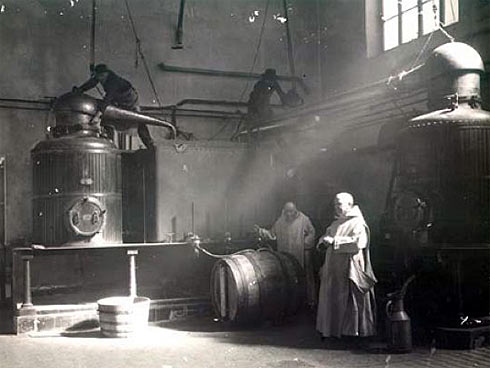
Above: Carthusian Monks producing the world famous Chartreuse Liqueur
at Marsielle, France in 1930.
While we have no precise recipe for "Chartreuse', because it remains a secret to this day, we are sure that it follows fairly closely an original script given to the French order of Carthusian (or Charterhouse) Monks in 1605. The order was expelled from France twice, first during the French Revolution and secondly in 1903, when they moved their distillery to Tarragona in Spain. It is made on a base of brandy Spirit with extracts of a considerable number of herbs and plants. It is chiefly known as a green liqueur but it is also made in a yellow, less alcoholic and sweeter style.
"Benedictine" must also be included in this "classic" area although its production was discontinued for seventy years, from the time of the French Revolution. It was reputedly first compounded by Dom Bernardo Vincelli at the Benedictine Monastery in Fecamp in 1510. Based on Brandy and flavoured with herbs, spices and fruit peels, it was designed to fortify and restore the weary monks. The initials D.O.M. on each authentic bottle indicate "Deo Optimo Maximo" - To God, Most Good, Most Great.
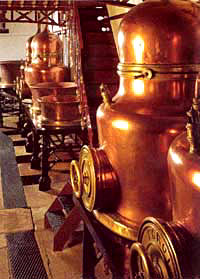 In 1727 a French writer of the time, Francois Guislier de Verges brought a modicum of modernity to liqueurs when he referred to them as "Conversation beverages" to be consumed with after-dinner conversation and of which he remarked "one might drink three times the quantity of other spirits without injury". Quite obviously M. Guislier and liqueurs were easy and good acquaintances because he added; "They are nourishing and strengthening to the stomach, alterative, pleasant to the taste and friends to the liver and other viscera". We might say it differently these days but I suspect we might mean the same thing.
In 1727 a French writer of the time, Francois Guislier de Verges brought a modicum of modernity to liqueurs when he referred to them as "Conversation beverages" to be consumed with after-dinner conversation and of which he remarked "one might drink three times the quantity of other spirits without injury". Quite obviously M. Guislier and liqueurs were easy and good acquaintances because he added; "They are nourishing and strengthening to the stomach, alterative, pleasant to the taste and friends to the liver and other viscera". We might say it differently these days but I suspect we might mean the same thing.
In an historical sense "Ratafia" is an interesting word in its application to Liqueurs. It was used for many years in a generic sense to apply to any liqueur drunk at the ratification of a treaty or agreement. More recently and particularly in England, Ratafia came to be understood as a liqueur flavoured with almonds or the kernels of peaches, cherries and apricots.
From what has been said so far, it can be seen that from early days to the end of the 18th century liqueurs were chiefly based for flavour on plants, herbs and spices with a clearly defined slant that though you might like them, they were primarily to do you and your stomach good. But as we moved into the 19th century with its involvement, not to say preoccupation, with the better things of life, liqueurs started to branch out as it were. Spices became more widely used as we shall discuss later and fruit flavours came to be accepted and demanded.
France had until then shared the bulk of the production of liqueurs with Italy, but in the 19th Century other countries began developing their own inimitable varieties. Holland became famous for its Curacaos and Germany and Denmark founded great liqueur houses. Scotland, Ireland and England began using their own domestic spirits with locally grown fruits and herbs.
But with the dawn of the 20th century we have seen the widest development of resources in the Liqueur making field. Where we started in the middle ages with solely brandy-based spirit, there is now no beverage spirit produced which is not used for liqueurs: Whisky; Rum; Tequila; Vodka; spirit made from Rice Wine or from fruits other than grapes; neutral or relatively tasteless spirit made from sugar cane or grain; anything, provided it is pure and wholesome will serve as a base. And as for flavours, there is no end to their sources as there is no end to man's ingenuity - all the edible fruits; cherries, oranges, passionfruit, bananas, apricots, mandarins, are all used. Cocoa and Coffee were natural targets for the Liqueurist in the field of beans as were Hazel Nuts and Almonds in the Nut bag.
About the Author: Eddie Baitz - An Aussie Success Story.
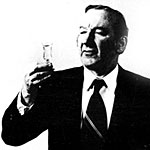 Australia may appear to many an unlikely place to have nurtured the delicate and demanding art of liqueur making. The harshness of its landscape and the rugged character of its early inhabitants would seem to have been unsympathetic to the emergence of such an essential European tradition. It was not without difficulty, that the founder of the Baitz Liqueurs, Clifford Baitz, and his son Edward established their enterprise early in the century. With tenacity and a stubborn refusal to produce products except to the highest international standards, Baitz Liqueurs have become known to Australia and the world winning more awards than any other maker in Australia. The judges in the 19th International Wine & Spirits Show in the United Kingdom recognised this with Baitz Cherry Brandy awarded the 1988 Quest International Trophy for the Best Liqueur (Category Worldwide). Baitz Cherry Brandy also received a Gold Award and Baitz Creme de Menthe and Baitz Creme de Cacao both received Silver Awards. The highly acclaimed 'Lillie Trophy' in Melbourne, Australia, which was first awarded in 1951, has been won by Baitz almost every year.
Australia may appear to many an unlikely place to have nurtured the delicate and demanding art of liqueur making. The harshness of its landscape and the rugged character of its early inhabitants would seem to have been unsympathetic to the emergence of such an essential European tradition. It was not without difficulty, that the founder of the Baitz Liqueurs, Clifford Baitz, and his son Edward established their enterprise early in the century. With tenacity and a stubborn refusal to produce products except to the highest international standards, Baitz Liqueurs have become known to Australia and the world winning more awards than any other maker in Australia. The judges in the 19th International Wine & Spirits Show in the United Kingdom recognised this with Baitz Cherry Brandy awarded the 1988 Quest International Trophy for the Best Liqueur (Category Worldwide). Baitz Cherry Brandy also received a Gold Award and Baitz Creme de Menthe and Baitz Creme de Cacao both received Silver Awards. The highly acclaimed 'Lillie Trophy' in Melbourne, Australia, which was first awarded in 1951, has been won by Baitz almost every year.
